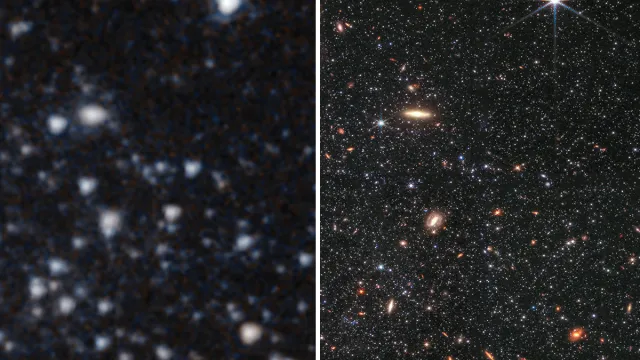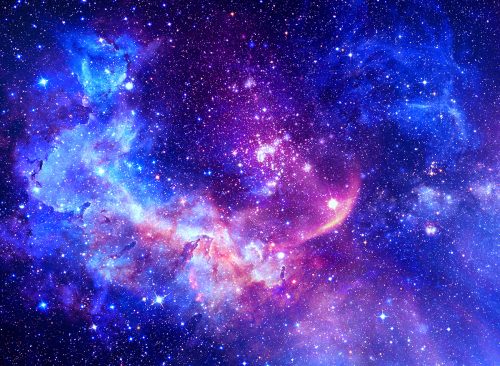Astonishing Photos of “Lonely” Galaxy 3 Million Light Years From the Milky Way, Captured by NASA
"It's really a gorgeous image."

This week, NASA shared images of a “lonely” galaxy three million light years from Earth. Taken by the James Webb Space Telescope (JWST), they showed the dwarf galaxy (known as Wolf-Lundmark-Melotte, or WLM) in unprecedented detail, including thousands of stars. The galaxy was previously spotted by another telescope in 2016, but its much lower resolution only revealed a field of blurry spots.
The Webb telescope uses near-infrared spotting technology that can capture more, and clearer, images of celestial bodies. NASA hopes these images of WLM will help them study the formation and early days of the universe: The galaxy is so secluded that it retains a chemical composition similar to galaxies present when the universe was young.
“We think WLM hasn’t interacted with other systems, which makes it really nice for testing our theories of galaxy formation and evolution,” said Kristen McQuinn of Rutgers University, who works on the project, in a NASA blog post. “Many of the other nearby galaxies are intertwined and entangled with the Milky Way, which makes them harder to study.” Read on to find out more.

The Webb telescope contains an NIRCM, or near-infrared camera. It’s the world’s most powerful space observatory, capable of bringing distant stars into sharper focus than ever before and detecting space bodies that are invisible to the human eye. The images of WLM were taken as part of Webb’s Early Release Science (ERS) program 1334, which focuses on nearby galaxies.
Yes, even though WLM is 3 million light-years away, it’s considered relatively close to Earth. Discovered in 1909, it’s about one-tenth the size of the Milky Way. Researchers believe it can unlock some mysteries about how the universe developed.

“Another interesting and important thing about WLM is that its gas is similar to the gas that made up galaxies in the early universe. It’s fairly unenriched, chemically speaking,” said McQuinn in a statement. “This is because the galaxy has lost many of these elements through something we call galactic winds.”
“Although WLM has been forming stars recently—throughout cosmic time, really—and those stars have been synthesizing new elements, some of the material gets expelled from the galaxy when the massive stars explode,” she said. “Supernovae can be powerful and energetic enough to push material out of small, low-mass galaxies like WLM.”

The images provided by the Webb telescope are clarion-clear and sparkle with color. They have even seasoned scientists gushing with childlike wonder. “We can see a myriad of individual stars of different colors, sizes, temperatures, ages, and stages of evolution; interesting clouds of nebular gas within the galaxy; foreground stars with Webb’s diffraction spikes; and background galaxies with neat features like tidal tails. It’s really a gorgeous image,” said McQuinn.
“And, of course, the view is far deeper and better than our eyes could possibly see. Even if you were looking out from a planet in the middle of this galaxy, and even if you could see infrared light, you would need bionic eyes to be able to see what Webb sees.”

NASA hopes to use the new data to reconstruct how stars formed in the WLM galaxy. Low-mass stars can live for billions of years, so it’s plausible that some stars within WLM formed during the early days of the universe. “By determining the properties of these low-mass stars (like their ages), we can gain insight into what was happening in the very distant past,” said McQuinn. “It’s very complementary to what we learn about the early formation of galaxies by looking at high-redshift systems, where we see the galaxies as they existed when they first formed.”
RELATED: The 10 Most “OMG” Science Discoveries of 2022

WLM was first spotted in 1909 by astronomer Max Wolf. In 1926, fellow astronomers Knut Lundmark and Philibert Jacques Melotte were credited with describing the nature of the galaxy, so the star group carries the names of all three. It is part of the constellation Cetus. Although isolated, the galaxy appears to be quite active, forming new stars. “Telltale pinkish star forming regions and hot, young, bluish stars speckle the isolated island universe,” says NASA. “Older, cool yellowish stars fade into the small galaxy’s halo, extending about 8,000 light-years across.”














